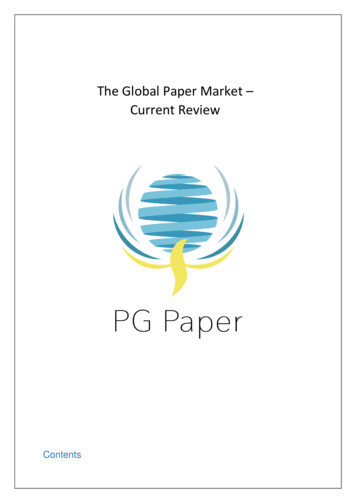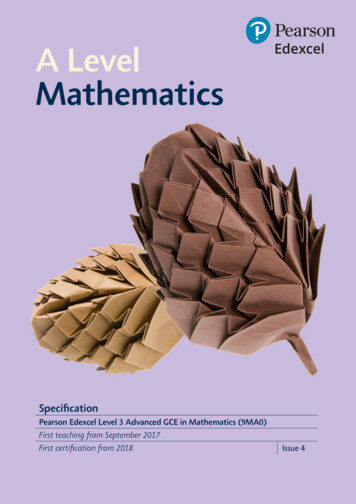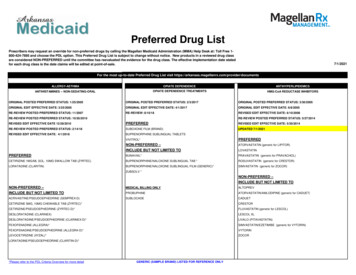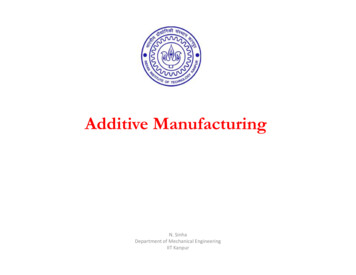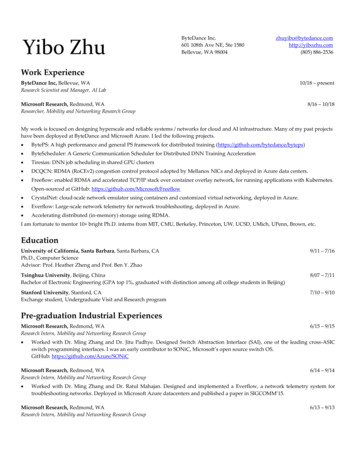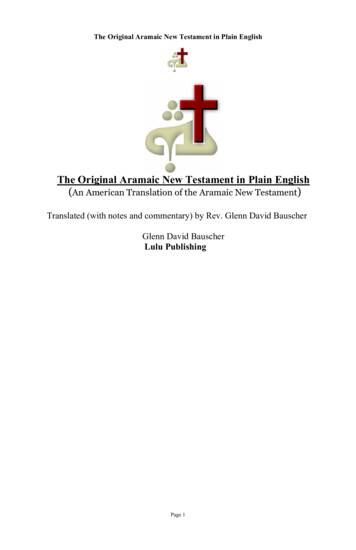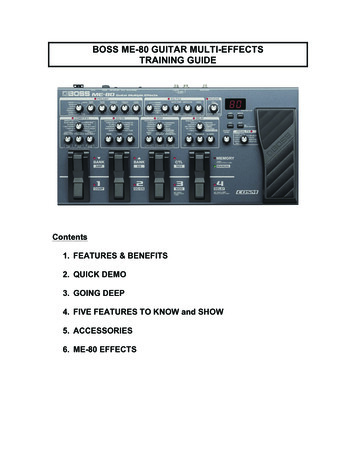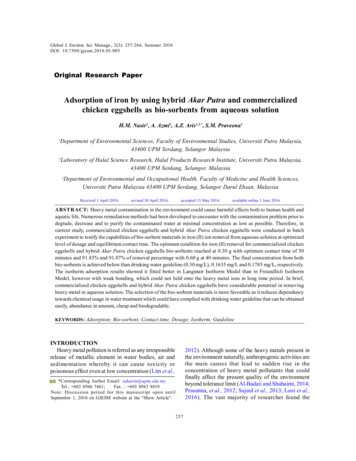
Transcription
GlobalJ. Environ.Sci. Manage.,2(3): 257-264, Summer 2016Global J. Environ. Sci. Manage., 2(3):257-264,Summer2016DOI: 10.7508/gjesm.2016.03.005Original Research PaperAdsorption of iron by using hybrid Akar Putra and commercializedchicken eggshells as bio-sorbents from aqueous solutionH.M. Nasir1, A. Azmi1, A.Z. Aris1,2,*, S.M. Praveena31Department of Environmental Sciences, Faculty of Environmental Studies, Universiti Putra Malaysia,43400 UPM Serdang, Selangor Malaysia2Laboratory of Halal Science Research, Halal Products Research Institute, Universiti Putra Malaysia,43400 UPM Serdang, Selangor, Malaysia3Department of Environmental and Occupational Health, Faculty of Medicine and Health Sciences,Universiti Putra Malaysia 43400 UPM Serdang, Selangor Darul Ehsan, MalaysiaReceived 1 April 2016;revised 30 April 2016;accepted 15 May 2016;available online 1 June 2016ABSTRACT: Heavy metal contamination in the environment could cause harmful effects both to human health andaquatic life. Numerous remediation methods had been developed to encounter with the contamination problem prior todegrade, decrease and to purify the contaminated water at minimal concentration as low as possible. Therefore, incurrent study, commercialized chicken eggshells and hybrid Akar Putra chicken eggshells were conducted in batchexperiment to testify the capabilities of bio-sorbent materials in iron (II) ion removal from aqueous solution at optimizedlevel of dosage and equilibrium contact time. The optimum condition for iron (II) removal for commercialized chickeneggshells and hybrid Akar Putra chicken eggshells bio-sorbents reached at 0.30 g with optimum contact time of 50minutes and 91.83% and 91.07% of removal percentage with 0.60 g at 40 minutes. The final concentration from bothbio-sorbents is achieved below than drinking water guideline (0.30 mg/L), 0.1635 mg/L and 0.1785 mg/L, respectively.The isotherm adsorption results showed it fitted better in Langmuir Isotherm Model than in Freundlich IsothermModel, however with weak bonding, which could not held onto the heavy metal ions in long time period. In brief,commercialized chicken eggshells and hybrid Akar Putra chicken eggshells have considerable potential in removingheavy metal in aqueous solution. The selection of the bio-sorbent materials is more favorable as it reduces dependencytowards chemical usage in water treatment which could have complied with drinking water guideline that can be obtainedeasily, abundance in amount, cheap and biodegradable.KEYWORDS: Adsorption; Bio-sorbent; Contact time; Dosage; Isotherm; GuidelineINTRODUCTIONHeavy metal pollution is referred as any irresponsiblerelease of metallic element in water bodies, air andsedimentation whereby it can cause toxicity orpoisonous effect even at low concentration (Lim et al.,2012). Although some of the heavy metals present inthe environment naturally, anthropogenic activities arethe main causes that lead to sudden rise in theconcentration of heavy metal pollutants that couldfinally affect the present quality of the environmentbeyond tolerance limit (Al-Badaii and Shuhaimi, 2014;Prasanna, et al., 2012; Sujaul et al., 2013; Looi et al.,2016). The vast majority of researcher found the*Corresponding Author Email: zaharin@upm.edu.myTel.: 603 8946 7461;Fax. : 603 8943 8019Note: Discussion period for this manuscript open untilSeptember 1, 2016 on GJESM website at the “Show Article”.257
H.M. Nasir et al.Global J. Environ. Sci. Manage., 2(3): 257-264, Summer 2016contamination of heavy metal in the river water bodieswhich can be easily be identified like cadmium,manganese, nickel, cobalt, chromium), copper, lead, iron,mercury, uranium, selenium, zinc, arsenic, silver (Alhayaet. al., 2003; Lim et al., 2012; Prasanna et. al., 2012; Sujaulet.al., 2013; Al-Badaii et al., 2013) that discharge fromthe industrial sector. These sectors allow the effluenteven without proper treatment and could contribute tovarious heavy metals pollution to the river water bodiesthat need the high cost of treatment.Heavy metals like iron which can be found naturallythat present widely in daily foods such as variety ofmeats and vegetables, which are more easily absorbedin the body through meat ingestion (Lenntech, 2015).The requirement of iron in the body are in different intakebased on the genders and ages whereby infants andchildren d” 8 years old required in average about d” 10mg/day. Meanwhile males and females e” 8 years oldneed in average about 8 mg/day. In fact, the ironsystematic balancing of iron in the body is dependingon the signaling mechanisms in the body known ashepcidin-FPN which responsible for iron supply,utilization, recycling and storage (Guo et. al., 2015).However, human body requires an appropriate iron levelintake as agents to transport oxygen throughout thewhole body in hemoglobin. Other than that, it is usuallybeing applied and used widely in various purposes forindustries, human and animals supplement also as plantsadditives supplements (Ankerpoort, 2015). Therefore,iron homeostasis in blood circulation has to be in acontrolled amount, as it is capable to animate thegeneration of radicals, which intrude and disruptmacromolecules in, cellular by promoting cell death andtissue impairment (Papanikolaou and Pantopoulos,2005). However, excessive iron inhalation and ingestionwould cause chronic diseases such as pneumoconiosisalso lung cancer. Moreover, the attachment of excessiveiron in environment in the manner of iron(III)-o-arseniteand iron(III)-o-pentahydrate that persistent, hazardousand could be affects the eco-balance have some adverseeffects and damages beyond imagination towards healthproblem without seeking solution for removal (Tinaroth,2012). According to Torti and Torti (2011), the excessiveiron bioaccumulation either in the liver, tissue and otherhuman body organ can allow development to malignanttransformation and hepatocellular cancerous cells.There are several approaches that had beenextensively used in removing heavy metal from the waterand wastewater such as chemical coagulation, electrochemical precipitation, electro-dialysis, ion exchange,membrane filtration, oxidation, phytoremediation, reverseosmosis, and ultrafiltration. Most of these processescan be unfavorable choices with their own disadvantagesdue to high cost, produces large and toxic sludge whichis undesirable end results (Basha et al., 2007), meanwhileion exchange method is not practicable as the cost ofthe synthetic ion-exchange resins could be costly(Ipeaiyeda and Tesi, 2014). Therefore, bio-sorption ispreferable approach as the bio-sorbent that used in theadsorption process are inexpensive (Lim and Aris,2014a;b), easy availability with collection from the foodprocessing production (Bailey et al., 1999; Jain et al.,2013; Lim and Aris, 2014a) and high efficiency removalof heavy metals from water (Zahra, 2012).Majority of bio-sorption experiments that have beenconducted throughout years either in removal of oil,lignosulfonate compounds, basic dye, methyl orange,toxic metals: copper, zinc, or even recoveries of preciousmetal (Won et al., 2014). Several studies have beenconducted based on the interest of the bio-sorbentsmaterials which contains calcium carbonate such as: deadcalcareous skeleton (Lim and Aris, 2014b); seashells(Chowdhury and Saha, 2012); bone charcoal (Wilson etal., 2003); clam, oyster, lobster (Tudor et al., 2005); shrimpshell; fish scales, coral which some of these bio-sorbentsused can removed heavy metal up to 200 mg/L. Besides,there are also several other household waste andindustrial waste that been widely used as bio-sorbentmaterials such as rubber, Hevea brasiliensis leaf powder(Kamal et al., 2009); banana peel, pumpkin peel, eggshell(Kanyal et al., 2015); tea waste (Thakur and Parmar, 2013)and etc. These materials shown good removal of heavymetals, however, eggshell is chosen in this experiment,as this material is eco-friendly, cost effective, widelyavailable in huge amount from the food waste andindustrial chicken livestock production waste (Lim andAris, 2014a).Bio-sorbent that being used must possess the highcapability in adsorption and desorption in order to beable to treat heavy metal more efficiently in a shortertime. Commercialized chicken eggshells (CCE) and hybridAkar Putra chicken eggshells (HAPCE) were chosen asthe bio-sorbents materials in heavy metal removal fromaqueous solution, due to its abundance sources (farm,household and industrial waste), water solubility, highsurface of homogeneity which allow metal ions and largeorganic nutrient cross-linked with protein molecules(Cordeiro, 2015), low cost and biocompatibilityproperties. The aim of this study were to investigatethe potential of CCE and HAPCE as bio-sorption in Fe258
Global J. Environ. Sci. Manage., 2(3): 257-264, Summer 2016removal at optimize level of dosage and contact time inequilibrium condition. The main goal in this study is toachieve the Fe removal by using CCE and HAPCE complywith drinking water guideline and applying the data inisotherm models. The present findings of Fe are abovethe drinking water and river water level requirement whichis 0.3 mg/L and 1.0 mg/L which it can caused toxicity tohuman bodies and aquatic organism even though itpresent in low dosages. Although it is well known thatpresence of little iron in the water bodies is required as abioavailability micronutrient to certain organisms andplants, however, when excess of the iron occurred, it posesthreat to the organism’s cells and tissue. Thus, monitoringof amount of heavy metal by following the mandatorystandard of drinking water and river water qualitystandards to remove Fe is important to provide a secureand healthy lifestyle to the human living and aquatic lifewhich depending on the water which is part of livingthings’ needs. This study has been performed inEnvironmental Forensics Laboratory of Halal ProductsResearch Institute, Universiti Putra Malaysia in 2015.hot and distilled water repeatedly to remove impuritiessuch as oil and sticky food waste on the surface of thecommercialized chicken eggshell. Then, dried at 70oC for4 hours (Nezhad et al., 2016) followed by crushing stepand sieved into the fraction size, 900 µm (Flores-cano etal., 2013) then kept in acid wash zip lock bag for directlyused in further analysis (Chowdhury et al., 2013).Batch experimentsThe batch adsorption experiment was set up at roomtemperature by using two different types of eggshell biosorbent at varying weight of eggshell bio-sorbent dosage0.15–0.90 g were added to 50 mL of iron metal syntheticsolution to produce several targeted concentrations,ranging from 0.5-2.5 mg/L. The experiments wereconducted at time interval of 180 minutes at initial pH inconstant turbulence speed of 150 rpm orbital shaker. Afterbeing shaken, the solution separated was withdrawn usingsyringe and filtered with 0.45 µm nylon-membrane filtersand the equilibrium of iron concentrations were analyzedby AAS. The calibration curve was prepared by using theiron standard in several concentrations ranging from 0.5to 2.0 mg/L prior the samples analysis to create the idealcalibration curve for detecting iron element. The validationmethod was analyzed by using the optimized value ofbio-sorbent dosage and equilibrium contact time. Theobtained results with qe value, quantity of metal adsorbedat equilibrium (mg/g) and the adsorption percentage, %was calculated by Eq. 1.MATERIALSAND METHODSMaterialsHybrid Akar Putra chicken eggshells (HAPCE) wereobtained from chicken barn at Universiti Putra Malaysia,Serdang, Malaysia and commercialized chicken eggshells(CCE) were collected by selected restaurant as food wastein Serdang. Ferrous (II) sulphate heptahydrate (SigmaAldrich, Switzerland), deionized water from Milli-Q system(Millipore Corp, USA) and concentrated nitric acid, HNO3,65% (Merck, Germany) were used as chemicals. The initialpH of synthetic solution was tested by using pH meter(Orion 2 Star, USA) and centrifuge machine (Rotofix 32,Zenttrigugen, Germany) for separation liquid and solidphase function. The concentration of iron was analyzedby using flame atomic adsorption spectroscopy (FAAS;AA-01-0440, Perkin Elmer, Canada). The laboratorysettings for this research has been performed inEnvironmental Forensics Laboratory from June –September 2015.qe (Ci – Ce) V(1)mwhere Ci and Ce are the initial at equilibrium metal ionconcentration in mg/L;qe represents the amount of heavy metal ion adsorbedonto adsorbent per weight (mg/g);V is the solution volume that being treated and m asmass of adsorbent. The experimental data obtained wereanalyzed using Langmuir and Freundlich isotherm model.RESULTS AND DISCUSSIONAnalysis of heavy metals by Flame Atomic AdsorptionSpectroscopy (FAAS)FAAS measures the concentration targeted elementsin environmental samples by the adsorbed radiation.FAAS detector measures the light transmitted by standardsolution and compared with the originally samplespassed through with specific wavelength. FAASoperation conditions are shown in Table 1. The standardsolutions were prepared for the analysis of Ferrous (II)MethodsAdsorbate and adsorbents preparationStock solution of 1000 mg/L of ferrous (II) ion wasprepared from Ferrous (II) sulphate heptahydrate,FeSO4.7H2O before diluted into several concentrations.The membrane HAPCE was manually peeled off andsoaked in water bath for 30 minutes prior rinsed withdistilled water. HAPCE and CCE were rinsed again with259
Adsorption of iron by using hybrid Akar PutraGlobal J. Environ. Sci. Manage., 2(3): 257-264, Summer 2016Table 1: FAAS Operation conditionsion concentration by FAAS. Several concentrations with0.5, 1.0, 1.5, 2.0 mg/L were prepared freshly with Milli-Qwater. Concentration vs absorbance is plotted in Fig. 1.Satisfactory values were obtained with r 0.9999 andthe recovery for the analyses were in the range of 100% 5% (95-99%).ParametersWavelengthLamp currentSignalFuel flowrateRun timeRecoveryPotential of CCE and HAPCE as bio-sorbent in Feremoval at optimum level of dosage and contact timein equilibrium conditionThe isotherm experiments had been carried out withseveral dosage of bio-sorbent, 0.15-1.5 g with constanttemperature, initial pH and initial concentration ofsynthetic solution, 2.0 mg/L. The selection of contacttime range was chosen according to Jai et al. (2007) andIpeaiyeda and Tesi, (2014). Findings revealed that mostof the contact time equilibrium reached within early 20until 75 minutes. The contact time was prolonged tohave a better view of the equilibrium curve.The results shown both of bio-sorbents dosage ofCCE and HAPCE illustrates immediate reduction in Feconcentration with initial 2.00 mg/L to lowest and highconcentration, whereby CCE bio-sorbent 0.19 mg/L, 0.9g bio-sorbent dosage and 0.86 mg/L, 0.15 g and HAPCEbio-sorbent 0.14 mg/L, 1.2 g and 0.98 mg/L, 0.15 g of biosorbent (Fig. 2). The concentration of Fe after treatmentwith different HAPCE and CCE dosage is illustrated inFig. 2. It shown that HAPCE have weak adsorptioninteraction (p 0.05) between heavy metal ions in theaqueous solution. Moreover, from the pattern of the trendline, it shown that, metal ion that attach on the surfaceof the eggshell cannot be hold in a long time of periodmore than 10-20 minutes. Therefore, the CCE bio-sorbentwith removal dosage efficiency at equilibrium time listedas followed 0.15 g 1.2 g 1.5 g 0.45 g 0.60 g 0.90 g 0.30 g. For HAPCE, the removal dosage efficiency atequilibrium time is 0.15 g 0.30 g 0.45 g 0.90 g 0.60g 1.2 g for HAPCE bio-sorbent. Generally, both of bio-Iron248.3 nm75%Continuous0.9 L/min4 sec95 - 99%sorbent types have a fluctuated tread line in iron removal,however the constant and more stable tread line withsmall dosage at faster contact time of CCE and HAPCEfound at 0.30 g at 50 minutes and 0.60 g at 40 minutes,respectively. The fluctuated reading, which may becaused by unstable adsorption of metal ion by theeggshell or can be due to reaching early short time periodof equilibrium where de-sorption taken placed rapidlyafter the adsorption phase.Comparison of Fe removal for CCE and HAPCE biosorbentComparison both of the bio-sorbent types were usedof the optimization values to comes out with the highestremoval efficiency. CCE and HAPCE found that havedifferent equilibrium rate in term of contact time andadsorbent dosage. Based on the optimization values ofthe contact time, CCE that have 10 minutes more ratherthan HAPCE shown that the small dosage, 0.30 g neededto remove up to 91.83% compared with HAPCE thatrequired 0.60 g of bio-sorbent dosage which is muchhigher than the amount that being required by CCE toachieved up to 91.07% of Fe removal. The results foundan almost similar removal trend (p 0.05) for both biosorbent types.As the removal efficiency depending on shortestcontact time which can remove iron concentration inthe aqueous solution up to drinking water qualityguideline requirement which is below than 0.3 mg/L(WHO, 2011) . Current findings were in agreement withAbsorbance2.52.0R² 0.99991.51.00.50.00.00.51.01.5Concentration (mg/L)Fig. 1: Calibration curve for Iron by FAAS2602.02.5
Global J. Environ. Sci. Manage., 2(3): 257-264, Summer 2016Fe concentration act time (min.)60906090120150180Fe concentration (mg/L)2.52.01.51.00.50.0-0.54050120150180Contact time (min.)0.15g0.30g0.45g0.60g0.90g1.2g1.5gFig. 2: Iron (II) removal for several dosages (a) CCE (b) HAPCEstudy conducted by Vijayaraghavan et al. (2006) wherehigher biosorbent dosage will produced the higheradsorption capacity. In contrast of CCE bio-sorbentwhich followed partially of the theory of higher amountof dosage present more available site to be attachedwith and thus more adsorption can be achieved (Raoet.al., 2010). This is due to at first 10 minutes of contacttime; the highest efficiency is achieved by CCE with0.90 g amount but not with the highest amount 1.5 g.However, the final results for both of bio-sorbent typesshown the final concentration Fe below than guidelinewhereby remain concentration of CCE is 0.1635 mg/Land also below than 0.3 mg/L for HAPCE with 2.0 mg/L as initial concentration of synthetic solutionconsidered as the concentration before treatment.The validation method was used optimized value of biosorbents dosage and equilibrium contact time from CCEand HAPCE were used to re-affirm the efficiency portraits.Fig. 3 illustrated percentage removal of Fe for each 0.30 gand 0.60 g of CCE and HAPCE whereby CCE view morestable with no significant difference (p 0.05) in highremoval efficiency condition compare to HAPCE bio-sorbent. Based on the experiments, it has concluded thatthe CCE bio-sorbent has better removal efficiency thanHAPCE in Fe aqueous solution whereas both of the finalconcentration after treatment below than drinking waterguideline of WHO, (2011) as shown in Fig.3.Adsorption isothermsAdsorption isotherm basically described theinteraction of adsorbate ion and adsorbent used in theaqueous solution, the remaining metals ions in theaqueous solution during surface bio-sorption and topresent the equilibrium that can achieved (Feng et. al.,2010). These adsorption isotherms were used to calculatethe maximum adsorption capacity of bio-sorbent typesbased on the optimized values of dosage and contacttime. Langmuir and Freundlich isotherm model are theisotherms, which are broadly applied for bio-sorptionexperiment. Therefore, the fundamental process inadsorption isotherm is to determine the minimal capacityof adsorption towards the metal ions (Larous et al., 2005).Langmuir isotherm model shown the nature adsorptionof CCE and HAPCE as favorable categories whereby261
H.M. Nasir et al.Global J. Environ. Sci. Manage., 2(3): 257-264, Summer 2016100Removal Percentage (%)91.8%91.1%908070600.30g50400.60gCCE 0.1635 mg/L30HAPCE 0.1785 mg/L20100010203040506090120150180Contact time (min.)0.30g CCE0.30g HAPCE0.60g CCE0.60g HAPCEFig. 3: Iron (II) percentage removal for optimized dosage and contact time with final concentration of aqueous solution201/qey 3.9453x - 6.0812R² 0.9938(a)1510y 1.8099x 0.8912R² 0.99865001log qe-0.82-0.7(b)3-0.6451/Ce-0.5-0.467-0.38-0.29-0.1y 1.5219x - 0.0677R² 0.9861y 1.043x - 0.624R² 0.9587log CeCCEHAPCE100.0-0.2 0-0.4-0.6-0.8-1.0-1.2-1.4-1.6Fig. 4: Isotherm model for CCE and HAPCE (a) Langmuir (b) Freundlichthe value of RL within the range, 0 RL 1 that indicatesit is well fitted with Langmuir isotherm model with R2 is0.9938 and R2 is 0.9986, respectively, as illustrated inFig. 4(a) and as a comparison to Freundlich isothermmodel in Fig. 4(b). The monolayer adsorptionmechanism was found in Langmuir and heterogenouslayer in Freundlich isotherm. Other than that,Freundlich isotherm model results indicate of sorbentadsorbate is cooperative adsorption. Meanwhile theunfavorable sorption of iron was obtained (n 0.6667)as shown in Table 2. Other than that, the HAPCEadsorbent, shown the normal process with n 1.230 thatindicates the favorable adsorption which is fitted withFreundlich isotherm.Thus, both of CCE and HAPCEbio-sorbent were best fitted on Langmuir isotherm asboth value of R2 obtained in Langmuir Isotherm muchhigher rather than the R2 value in Freundlich Isotherm(Fig. 4(a) and Fig. 4(b) as well as Table 2).262
Global J. Environ. Sci. Manage., 2(3): 257-264, Summer 2016Table 2: Langmuir and Freundlich isotherm models for both bio-sorbentsMetal ion (Fe)CCEHAPCEKL 0.003410.9986CONCLUSIONThe adsorption of Fe ion onto CCE and HAPCE weredepended on the two variables, which are contact timeand bio-sorbent dosages. Percentage removals in thisexperiment differ depending to increase of contact timeand dosage of bio-sorbents used whereby eachparameter give different results depending on the biosorbent material. Final concentration of aqueous solutionis prominent aspect that needs to comply with WHOdrinking water guidelines, which is less than 0.3 mg/L ofFe ion in drinking water and 1.0 mg/L in natural riverwater. Both CCE and HAPCE has been proved to have apotential in Fe ion removal whereby the final treatedconcentration is below than the guideline, 0.1635 mg/Land 0.1785 mg/L, respectively. The removal percentageof CCE and HAPCE bio-sorbent increased up to 91.83%and 91.07% with the initial concentration of 2.0 mg/Lwhich were successfully removed by using 0.30 g ofCCE at equilibrium contact time of 50 minutes and less10 minutes of 0.60 g of HAPCE bio-sorbent dosage wereobtained at constant of pH temperature and agitationrate in orbital shaker. In term of adsorption isotherms,both of bio-sorbent better being described in Langmuirisotherm model with correlation coefficient, R2 is 0.9938and 0.9986 compared with R2 is 0.9861 and 0.9587,respectively of Freundlich isotherm model. The selectedmethod in this study is superior to previous studieswith different selection of targeted final concentrationwhich could be complied with drinking water qualityguideline by using of eggshell waste. Overall, it can beconcluded that commercialized chicken eggshell andhybrid Akar Putra chicken eggshell both are capable inremoval of iron ions from the aqueous solution. Bothare potentially applicable in the drinking water treatmentapproach. However, CCE can be considered as the bestbio-sorbent material compared to HAPCE providing aneconomical and efficient sounds portable water treatmentapproach option especially for drinking water supply.n0.66671.2301FreundlichLog KFR2-0.06770.9861-0.62400.9587CONFLICT OF INTERESTThe authors declare that there are no conflicts ofinterest regarding the publication of this manuscript.REFERENCESAl-Badaii, F.; Shuhaimi, O.M., (2014). Heavy metal and waterquality assessment statistical techniques and water qualityindex of the Semenyih River, Peninsular Malaysia. Iran. J.Energy Environ., 5(2): 132–145 (14 pages).Al-Badaii, F.; Suhaimi, O.M.; Gasim, M.B., (2013). Researcharticle: Water quality assessment of the Semenyih River,Selangor, Malaysia. J. Chem. Vol. 2013.Ankerpoort, N.V., (2015). Scientific Opinion on the safetyand efficacy of iron compounds (E1) as feed additives forall animal species: Ferrous carbonate based on a dossier. Eur.Food Safety Auth., 13(5): 4109.Basha, C.A.; Selvi, S.J.; Ramasamy, E.; Chellammal, S., (2007).Removal of arsenic and sulphate from the copper smeltingindustrial effluent. Chem. Eng. J., 141(1-3): 89-98 (10 pages).Chowdhury, S.; Saha, P.D., (2012). Fixed-bed adsorption ofMalachite Green onto binary solid mixture of adsorbents:Seashells and eggshells. Toxicol. Environ. Chem., 94: 7.Chowdhury, S.; Chakraborty, S.; Saha, P.D., (2013). Removal ofcrystal violet from aqueous solution by adsorption onto eggshell:Equilibrium, kinetics, thermodynamics and artificial neuralnetwork modeling. Waste Biomass Valor. 4: 655–664 (10pages).Cordeiro, C.M.M., (2015). Eggshell membrane proteins provideinnate immune protection. University of Ottawa, Canada.Department of Cellular and Molecular Medicine.Feng, N.; Guo, X.; Liang, S.; Zhu, Y.; Liu, J., (2010). Biosorptionof heavy metals from aqueous solutions by chemically modifiedorange peel. J. Hazard. Mater.,185 (1): 49-54 (6 pages).Flores-Cano, J.V.; Leyva-Ramos, R.; Mendoza-Barron, J.; GuerreroCoronado, R.M.; Aragon-Pina, A.; Labrada-Delgado, J., (2013).Sorption mechanism of Cd (II) from water solution into chickeneggshell. Appl. Surface Sci., 276: 682-690 (9 pages).Guo, W.; Zhang, J.; Li, W.; Xu, M.; Liu, S., (2015). Disruption ofiron homeostasis and resultant health effects upon exposure tovarious environmental pollutants: A critical review. J. Environ.Sci., 34: 155-164 (10 pages).Ipeaiyeda, A.R.; Tesi, G.O., (2014). Sorption and desorption studieson toxic metals from brewery effluent using eggshell asadsorbent. Adv. Natural Sci., 7 (2): 15-24 (10 pages).Jai, P.H.; Wook, J.S.; Kyu, Y.J.; Gil, K.B.; Mok, L.S., (2007).Removal of heavy metals using waste eggshells. J. Environ.Sci., 19(12): 1436-1441 (6 pages).Jain, M.; Garg, V.K.; Kadirvelu, K., (2013). Chromium removalfrom aqueous system and industrial wastewater by agriculturalwastes. Bioremediat J. 17(1): 30–39 (10 pages).Kamal, M.H.M.A.; Azira, W.M.K.W.K.; Kasmawati, M.;Haslizaidi, Z.; Saime, W.N.W., (2009). Sequestration of toxicPb(II) ions by chemically treated rubber (Heavea Brasiliensis)ACKNOWLEDGEMENTThis work was funded by Ministry of HigherEducation, Malaysian through the FundamentalResearch Grant Scheme (FRGS) under the project code07-01-15-1656FR.263
Adsorption of iron by using hybrid Akar PutraGlobal J. Environ. Sci. Manage., 2(3): 257-264, Summer 2016leaf powder. J. Environ. Sci., 22 (2): 248-256 (9 pages).Larous, S.; Meniai, A.H.; Lehocine, M.B., (2005). Experimental studyof the removal of copper from aqueous solutions by adsorptionusing sawdust. Desalination. 185(1-3): 483-490 (8 pages).Lenntech, (2015) Chemical properties of iron–Health effects ofiron–Environmental effects of iron. Published by LenntechRotterdamseweg.Lim, A.P.; Aris, A.Z., (2014a). A review on economically adsorbentson heavy metals removal in water and wastewater. Rev. Environ.Sci. Biotech., 13(2), 163-181 (19 pages).Lim, A.P.; Aris, A.Z., (2014b). A novel approach for the adsorptionof cadmium ions in aqueous solution by dead calcareous sketons.Desalination Water Treat., 52:16-18 (3 pages).Lim, W.Y.; Aris, A.Z.; Zakaria, M.P., (2012). Spatial variability ofmetals in surface water and sediment in the langat river andgeochemical factors that influence their water-sedimentinteractions. Sci. World J., ID 652150, Doi: 10.1100/2012/652150. (14 pages)Looi, L.J.; Aris, A.Z.; Haris, H.; Yusoff, F.M.; Hashim, Z., (2016).The levels of mercury, methylmercury and selenium and theselenium health benefit value in grey-eel catfish (Plotosus canius)and giant mudskipper (Periophthalmodon schlosseri) from theStrait of Malacca. Chemosphere, 152, 265-273 (9 pages).Nezhad, M.J.; Khodabakhshi, S.J.F.; Bakhshi, H., (2016).Preparation and evaluation of chitosan-coated eggshell particlesas copper (II) biosorbent. Desalination Water Treat., 57(4):1693-1704 (12 pages)Papanikolaou, G.; Pantopoulos, K., (2005). Iron metabolism andtoxicology. Toxicology and applied pharmacology. 202(2): 199211 (13 pages).Prasanna, M.V.; Praveena, S.M.; Chidambaran, S., (2012).Evaluation of water quality pollution indices for heavy metalcontamination monitoring: a case study from Curtin Lake, MiriCity, East Malaysia. Environ. Earth Sci. 67: 1987–2001(15pages).Rao, H.J.; Kalyani, G.; Rao, K.V.; Kumar, T.A.; Maridas, K.; Kumar,Y.P.; Vijetha, P.; Pallavi P.; Sumalatha, B.; Kumaraswamy,K., (2010). Kinetic studies on biosorption of lead from aqueoussolution using eggshell powder. Int. J. Biotech.Biochem., 6(6):957-968. (11 pages)Sujaul, I.M., Hoossain, M.A., Nasly, M.A., and Sobahan, M.A.,(2013). Effect of Industrial Pollution on the Spatial Variationof Surface Water Quality. American Journal of EnvironmentalScience, 9 (2): 120 – 129.Thakur, L.S.; Parmar, M., (2013). Adsorption of heavy metal(Cu2 , Ni2 , and Zn2 ) from synthetic waste water by teawasteaAdsorbent. Int. J. Chem. Phys. Sci., 2(6); 6-19 (14pages)Tinaroth, (2012). Iron: Health and environment effects.Ironmap Web. -effects/ )Torti, S.V.; Torti, F.M., (2011). Ironing out cancer. CancerRes., 71(5): 1511–1515 (5 pages).Tudor, H.E.A.; Gryte, C.C.; Harris, C.C., (2005). Seashells:Detoxifying agent for metal-contaminated waters.Water AirSoil Pollut., 173 (1): 209-242 (34 pages).Vijayaraghavan, K.; Padmesh, T.V.N.; Palanivelu, K.; Velan,M., (2006). Biosorptionof nickel (II) ions onto Sargassumwightii: Application two parameter and three-parameterisotherm models. J. Hazard. Mater., 133(1-3): 304-308 (5pages).Wilson, J.A.; Pilford, I.D.; Thomas, S., (2003). Sorption of Cuand Zn by bone charcoal. Environ. Geochem. Health., 25(1):51-556 (496 pages).WHO, (2011). Guidelines
and healthy lifestyle to the human living and aquatic life which depending on the water which is part of living things’ needs. This study has been performed in Environmental Forensics Laboratory of Halal Products Research Institute, Universiti Putra Malaysia in 2015. MATERIALS AND METHODS Materials Hybrid
